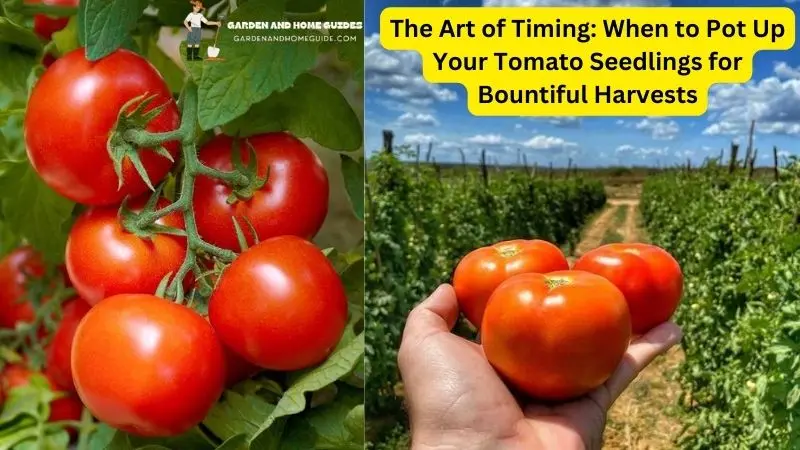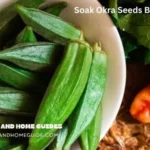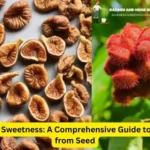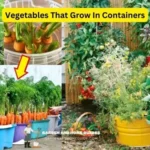Tree Care
When To Pot Up Tomato Seedlings for Bountiful Harvests
Tomato plants, with their vibrant foliage and juicy fruits, are a staple in many gardens. However, achieving a successful tomato harvest requires more than just planting seeds and hoping for the best.
One crucial step in the process is potting up, the act of transplanting seedlings from their initial seed trays or starter pots into larger containers. This seemingly simple action, when executed at the right time, can significantly influence the health, growth, and ultimately, the yield of your tomato plants.
This essay of Gardenandhomeguide.com explores the intricate relationship between timing and potting up tomato seedlings, delving into the factors that influence the optimal moment for this crucial step.
We will navigate the complexities of seedling development, environmental conditions, and the specific needs of different tomato varieties to understand how to maximize the chances of a bountiful harvest.
Understanding the Seedling’s Journey:
Before we delve into the timing of potting up, it’s essential to understand the developmental stages of a tomato seedling. From the moment a seed germinates, the plant embarks on a journey of rapid growth, fueled by the initial reserves within the seed and, subsequently, by the nutrients provided by the growing medium. This journey can be broadly divided into three distinct phases:
- The Germination Phase: This initial phase is characterized by the emergence of the radicle, the first root, followed by the cotyledons, the seed leaves. The cotyledons provide initial nourishment to the seedling until true leaves begin to develop.
- The Seedling Stage: This phase is marked by the emergence of true leaves, which are distinct from the cotyledons and are responsible for photosynthesis. The seedling continues to grow roots and shoots, establishing a strong foundation for future growth.
- The Transplanting Stage: This stage is reached when the seedling has developed a robust root system and several true leaves. The plant is now ready to be transplanted into a larger container or directly into the garden.
The Importance of Timing: When To Pot Up Tomato Seedlings?
The timing of potting up is crucial because it directly influences the success of the transplant. If potted up too early, seedlings may struggle to establish themselves in the larger container, leading to stunted growth or even death. Conversely, waiting too long can result in rootbound plants that are difficult to transplant and may experience transplant shock.
General Timeline: 4-6 weeks after sowing: This is a good general timeframe for potting up tomato seedlings. However, always observe your seedlings closely and adjust your timing based on their individual growth.
Factors Influencing the Optimal Time:
Several factors influence the optimal time to pot up tomato seedlings, each playing a crucial role in ensuring a smooth transition and healthy growth:
- Seedling Size: The most common indicator for potting up is the size of the seedling. Generally, seedlings are ready for transplanting when they have developed at least four true leaves and have reached a height of 4-6 inches. This indicates that the seedling has established a strong root system and is capable of supporting further growth.
- Root Development: A well-developed root system is essential for successful transplanting. The roots should be filling the current container, with some roots even emerging from the drainage holes. This signifies that the roots are ready to explore a larger space and access more nutrients.
- Environmental Conditions: The environment in which the seedlings are grown plays a significant role in determining the optimal time for potting up. Warm temperatures and ample sunlight promote faster growth, while cool temperatures and low light levels can slow down development.
- Tomato Variety: Different tomato varieties have different growth habits and maturity rates. Some varieties, like cherry tomatoes, are known for their rapid growth and can be potted up earlier than larger varieties like beefsteak tomatoes.
The Art of Observing:
While general guidelines exist, it’s crucial to observe the individual seedlings closely. Look for signs of rootboundness, such as roots circling the bottom of the container or emerging from the drainage holes. Also, observe the overall health and vigor of the seedling. A healthy seedling will have vibrant green leaves, a strong stem, and a well-developed root system.
Practical Tips for Potting Up:
- Choose the Right Container: Select a container that is at least 2-3 inches larger in diameter than the seedling’s current container. Ensure the container has adequate drainage holes to prevent waterlogging.
- Use a High-Quality Potting Mix: A well-draining potting mix rich in nutrients is essential for healthy growth. Avoid using garden soil, as it can be too dense and compact for young seedlings.
- Handle Seedlings with Care: When transplanting, handle the seedlings gently to avoid damaging the roots. Gently loosen the seedling from its current container and avoid disturbing the root ball.
- Water Thoroughly: After transplanting, water the seedlings thoroughly to ensure the roots are well-hydrated and the potting mix is settled around the root ball.
- Provide Adequate Sunlight: Place the potted seedlings in a sunny location, ensuring they receive at least 6-8 hours of direct sunlight per day.
Timing for Different Tomato Varieties:
While the general guidelines mentioned above are applicable to most tomato varieties, it’s essential to consider the specific growth habits of each variety. For instance:
- Early-Maturing Varieties: These varieties, like ‘Early Girl’ and ‘Celebrity’, can be potted up slightly earlier than later-maturing varieties. Their rapid growth rate allows them to quickly establish themselves in a larger container.
- Later-Maturing Varieties: Varieties like ‘Brandywine’ and ‘Heirloom’ tend to grow more slowly and require a longer period to develop a strong root system. Therefore, it’s best to wait until they have developed a robust root system before potting them up.
- Indeterminate Varieties: These varieties, like ‘Roma’ and ‘Beefsteak’, have a longer growing season and can continue to produce fruit throughout the summer. They require more space and can benefit from being potted up into larger containers as they grow.
- Determinate Varieties: These varieties, like ‘Patio’ and ‘Bush’, are compact and have a shorter growing season. They can be potted up into smaller containers, as they don’t require as much space to grow and produce fruit.
The Importance of Patience:
Potting up tomato seedlings is a crucial step in the journey to a bountiful harvest. However, it’s important to remember that patience is key. Don’t rush the process. Allow the seedlings to develop a strong root system and reach a healthy size before transplanting. By paying close attention to the individual needs of your seedlings and understanding the factors that influence the optimal time for potting up, you can set the stage for a successful tomato growing season.
Beyond the Pot:
The journey of a tomato plant doesn’t end with potting up. After transplanting, it’s crucial to provide ongoing care, including regular watering, fertilizing, and pest control. By nurturing your tomato plants throughout their growth cycle, you can ensure a healthy and productive harvest.
Conclusion:
Potting up tomato seedlings is an art form that requires a delicate balance of observation, timing, and care. By understanding the developmental stages of a seedling, the factors that influence the optimal time for potting up, and the specific needs of different tomato varieties, gardeners can ensure a smooth transition and maximize the chances of a bountiful harvest. Remember, the key is to observe your seedlings closely, provide them with the right conditions, and be patient. With careful attention and a little bit of knowledge, you can cultivate healthy, productive tomato plants that will reward you with juicy, flavorful fruits throughout the season.






